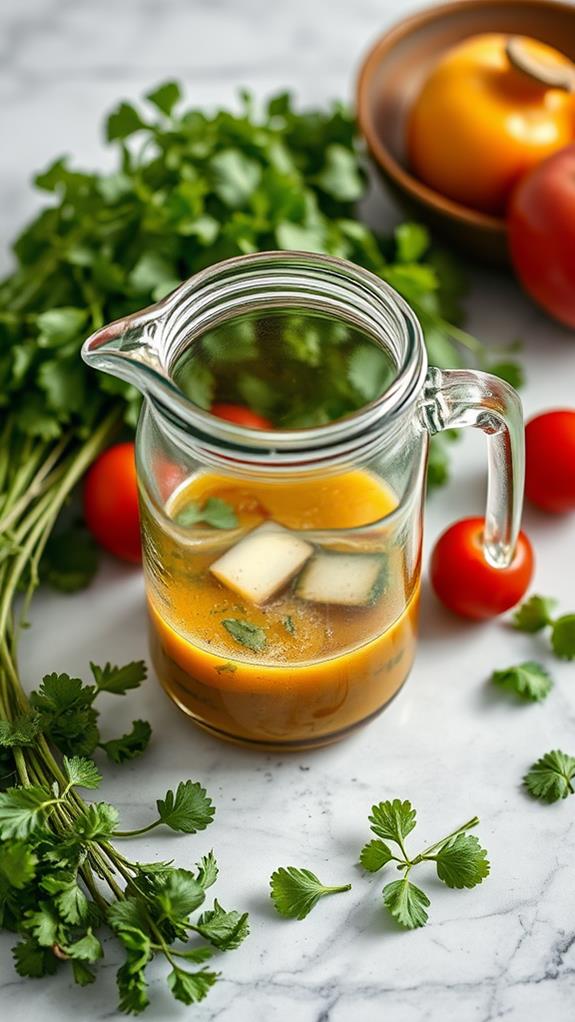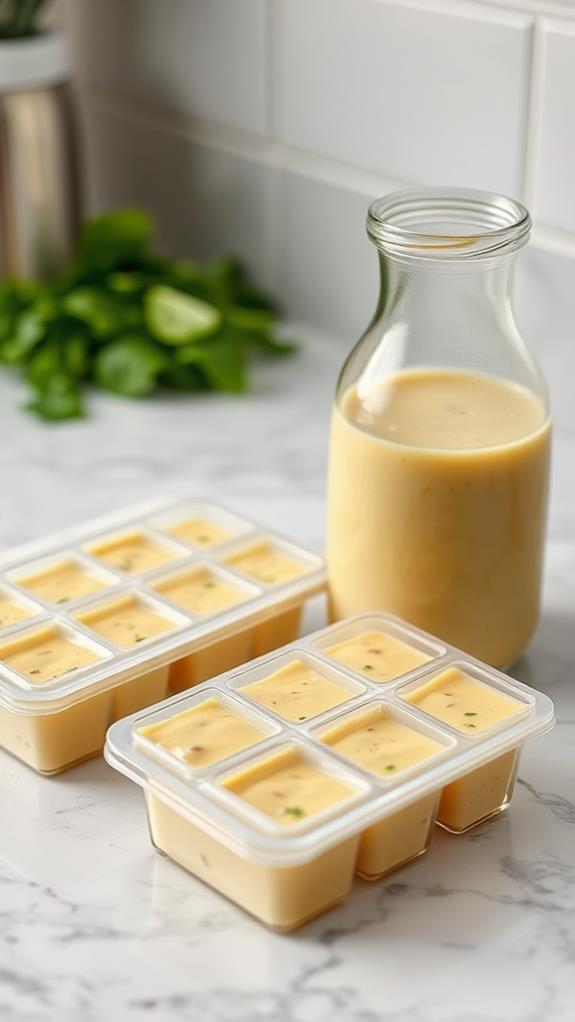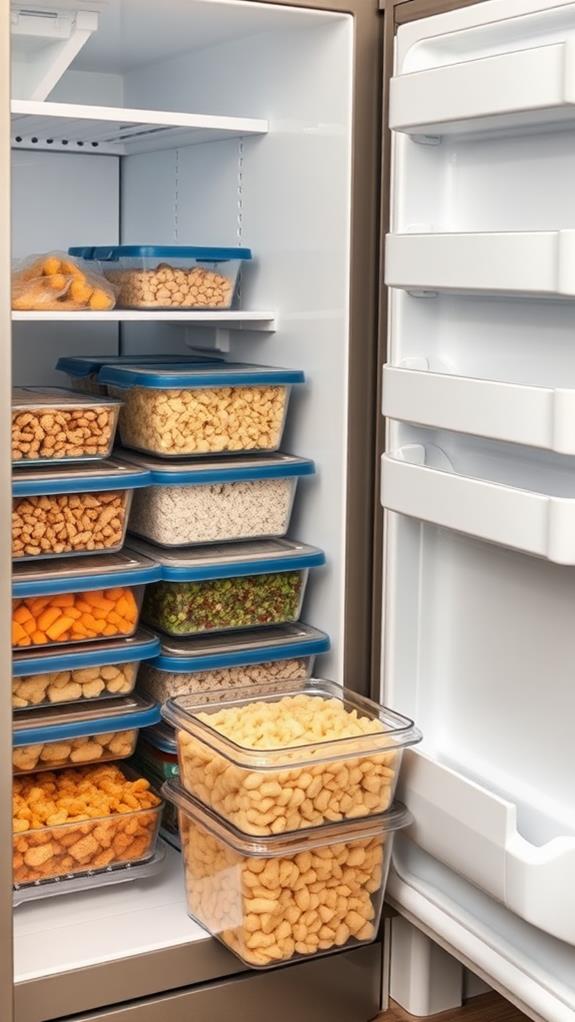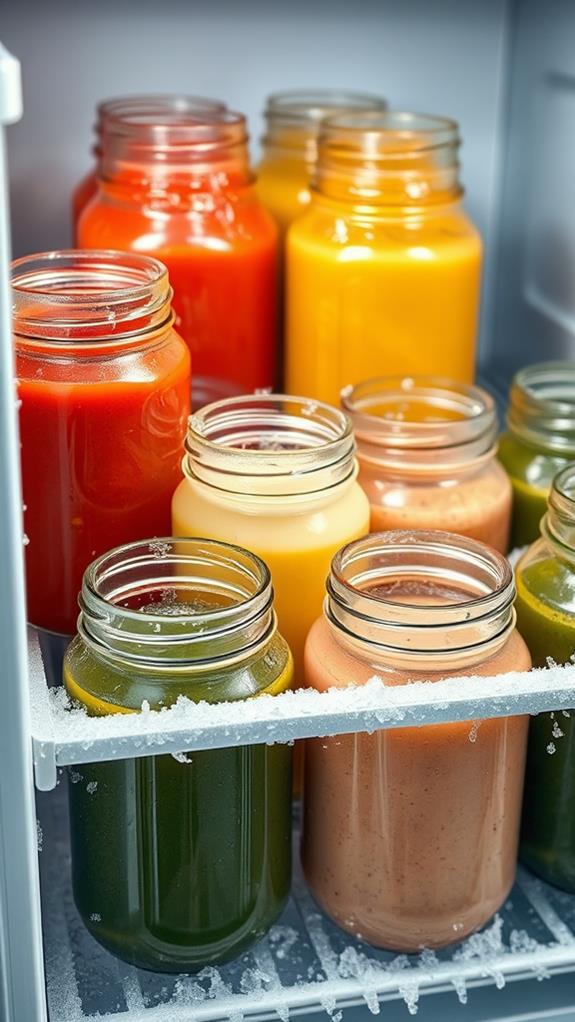Can You Freeze Dressing That Is Uncooked
Yes, you can freeze uncooked dressing, and it's often a better choice than freezing cooked dressing. Freezing uncooked dressing preserves its texture and flavor more effectively, making it ideal for holiday meal prep. To freeze properly, cool the dressing completely, then store it in airtight containers or freezer-safe bags. Remove as much air as possible to prevent freezer burn. You can keep uncooked dressing frozen for 2-6 months at 0°F (-18°C) or lower. When you're ready to use it, thaw the dressing in the refrigerator overnight, then bake it until it reaches an internal temperature of 165°F. The following sections will guide you through the entire process in detail.
This post may contain affiliate links. If you make a purchase through these links, I may earn a commission at no additional cost to you. Additionally, portions of this post may be generated using artificial intelligence (AI) technology. While we strive for accuracy, please be aware that AI-generated content may not always be perfect and should be fact-checked when necessary.
The Spatula Scoops
- Uncooked dressing can be frozen successfully, preserving texture and flavor better than cooked dressing.
- Use airtight containers or freezer-safe bags to prevent freezer burn and maintain quality.
- Proper cooling before freezing and maintaining a freezer temperature of 0°F (-18°C) or lower is crucial.
- Frozen uncooked dressing can be stored for 2-6 months, providing flexibility in meal planning.
- Thaw frozen dressing in the refrigerator overnight and ensure it reaches an internal temperature of 165°F when cooked.
Understanding Uncooked Dressing

When it comes to holiday meal prep, uncooked dressing can be a real time-saver. You might be wondering if you can freeze uncooked dressing, and the answer is a resounding yes. In fact, freezing uncooked dressing is often preferable to freezing the baked version, as it preserves the texture and flavor more effectively.
Understanding uncooked dressing is vital for maximizing its potential. When you freeze uncooked dressing, you're essentially putting the preparation process on pause. This means you can make your dressing well in advance, freeing up valuable time during the busy holiday season. The key to successfully freezing uncooked dressing lies in proper storage techniques. You'll want to use airtight containers or freezer-safe bags to prevent freezer burn and maintain the quality of your ingredients. For ideal portion control and easy storage, consider using silicone freezer molds with convenient fill lines, which can help you freeze individual servings of your uncooked dressing.
When you're ready to use your frozen uncooked dressing, you'll find that the thawing and cooking process is straightforward. Simply transfer the dressing to your refrigerator overnight to thaw evenly. Once thawed, you can cook it directly from its chilled state, ensuring it reaches an internal temperature of 165°F for food safety.
Benefits of Freezing Uncooked Dressing

Freezing uncooked dressing offers several advantages that can simplify your meal preparation and enhance your culinary experience. When you freeze uncooked dressing, you're preserving its original texture and flavor more effectively than if you were to freeze cooked dressing. This method allows you to maintain the integrity of your ingredients, ensuring a fresher taste when you're ready to serve. Using silicone freezer molds with convenient fill lines can help you portion and freeze your uncooked dressing more efficiently, making it easier to thaw only what you need.
One of the Best Tips for freezing uncooked dressing is to store it in airtight containers, which can keep it fresh for 2-6 months. This long shelf life gives you flexibility in your meal planning and allows you to prepare dressing in advance for future use. Additionally, freezing uncooked dressing simplifies the preparation process, saving you time and effort when you're ready to cook.
Preparing Dressing for Freezing

When preparing your uncooked dressing for freezing, you'll want to examine the ingredients you're using and their moisture content. Choose ingredients that freeze well, and if you're including vegetables, contemplate blanching them first to help maintain their texture. For easy portioning and storage, you might reflect on using silicone freezer molds designed for freezing various foods, including sauces and condiments. You'll also need to pay attention to how you package your dressing for freezing, using airtight containers or heavy-duty freezer bags to prevent freezer burn and maintain quality.
Proper Ingredients Selection
Selecting the right ingredients is pivotal when preparing uncooked dressing for freezing. You'll want to choose components that can withstand the freezing process while maintaining their texture and flavor. The best ingredients for freezable dressings are those with higher fat or starch content, such as bread or cornbread. These elements help preserve the dressing's structure during freezing and thawing.
When it comes to vegetables and herbs, be aware that they may become softer or change in texture after freezing. To mitigate this, you can reduce the amount of liquid in your recipe or add more binding ingredients. This approach will help maintain the desired consistency of your dressing once it's thawed.
Proper seasoning is essential for preserving flavor. You'll want to season your uncooked dressing adequately before freezing, as this will help maintain its taste profile throughout the process. Additionally, it's important to avoid overly moist dressings, as they're more likely to become mushy when thawed. By carefully selecting your ingredients and adjusting your recipe accordingly, you'll be able to create a dressing that freezes well and retains its quality when you're ready to use it.
Moisture Content Control
Controlling the moisture content of your uncooked dressing is imperative when preparing it for freezing. To guarantee your freeze dressing maintains its texture and flavor, you'll need to strike a balance between too wet and too dry. If your dressing is overly moist, it may become mushy or soggy when thawed and reheated. On the other hand, if it's too dry, it might lose its appealing texture.
To achieve the right moisture content, you can adjust your recipe by reducing the amount of liquid or adding more binding ingredients. This will help maintain the desired consistency of your dressing after freezing and thawing. Additionally, proper seasoning is paramount for preserving the flavor profile of your dressing throughout the freezing process.
When preparing your dressing for freezing, consider dividing it into smaller portions. This approach will make the thawing and reheating process more manageable and efficient. By taking these steps to control moisture content, you'll be able to successfully freeze your uncooked dressing while preserving its quality and taste for future use.
Packaging for Freezing
Proper packaging is key to successfully freezing uncooked dressing. When you're ready to freeze your dressing, you'll want to safeguard it's protected from freezer burn and maintains its texture. Start by dividing your uncooked dressing into smaller portions, which will make thawing easier later on. Use airtight containers or freezer-safe bags to store the dressing, removing as much air as possible before sealing.
Plastic containers are stackable and reusable, but may crack in the freezer. Freezer bags are space-saving and moldable, but have a potential for punctures. Glass containers don't leach chemicals, but are breakable and take up more space. Vacuum-sealed bags provide the best air removal and are compact, but require special equipment.
Don't forget to label your containers with the contents and freezing date. This simple step will help you keep track of your frozen dressing and guarantee you use it within a reasonable timeframe. By following these packaging guidelines, you'll be well on your way to preserving your uncooked dressing for future use.
Proper Freezing Techniques

Success in freezing uncooked dressing hinges on following the right techniques. When preparing your best cornbread dressing for freezing, start by allowing it to cool completely. This vital step prevents bacterial growth and guarantees proper freezing. Once cooled, divide the dressing into smaller portions, which will make thawing and reheating easier later on.
Next, you'll want to package your dressing properly. Use freezer-safe containers or bags, making sure they're airtight to prevent freezer burn and maintain the dressing's texture and flavor. When sealing the containers, remove as much air as possible to further protect your dressing.
Place the packaged dressing in your freezer, setting the temperature to 0°F (-18°C) or lower. This temperature is ideal for long-term storage, allowing your uncooked dressing to remain fresh for up to six months. Keep in mind that dressings with higher moisture content, particularly those containing vegetables, may experience some texture changes when frozen and thawed. By following these proper freezing techniques, you'll guarantee your uncooked dressing maintains its quality and taste for future use.
Thawing Frozen Uncooked Dressing

Thawing frozen uncooked dressing requires patience and careful planning. To guarantee food safety, you'll need to transfer your frozen dressing from the freezer to the refrigerator and let it thaw overnight. The thawing time will vary depending on the quantity and container size, so plan accordingly.
Once thawed, you can proceed with baking the dressing as per your original recipe. However, it's vital to verify that the internal temperature reaches 165°F for safe consumption. To promote even cooking, allow the thawed dressing to reach room temperature before baking.
Before cooking, always inspect your thawed dressing for any signs of spoilage. If you notice off odors or discoloration, it's best to discard it.
Here's a quick reference guide for thawing and cooking frozen uncooked dressing:
| Step | Action | Time |
|---|---|---|
| 1. Thaw | Refrigerate | Overnight |
| 2. Room Temp | Counter | 30-60 min |
| 3. Bake | Oven | As per recipe |
| 4. Check Temp | Thermometer | Until 165°F |
Cooking Previously Frozen Dressing

Cooking previously frozen dressing requires some adjustments to ascertain the best results. When you're ready to cook your thawed dressing, you'll need to account for the moisture content that may have increased during the freezing and thawing process. To counter this, you might want to add a bit more bread or cornbread to absorb excess liquid.
Preheat your oven to 350°F (175°C). Transfer the thawed dressing to a greased baking dish, spreading it evenly. If the mixture seems too dry, you can add a small amount of broth to achieve the desired consistency. Cover the dish with foil to prevent over-browning and place it in the preheated oven.
Bake the dressing for about 45 minutes, then remove the foil and continue baking for an additional 15-20 minutes until the top is golden brown and crispy. The internal temperature should reach 165°F (74°C) to validate it's fully cooked and safe to eat.
Storage Duration and Safety Tips

When it comes to storing uncooked dressing in the freezer, you'll want to keep a few key points in mind. Uncooked cornbread dressing can be safely frozen for up to 3-4 months when properly stored. To maintain exemplary quality, use airtight containers or freezer-safe bags to prevent freezer burn and preserve flavor.
Before freezing, make sure your dressing has cooled completely. This step is imperative for food safety and helps maintain the texture of your dressing. You'll find it helpful to divide the uncooked dressing into smaller portions before freezing. This practice not only makes thawing easier but also allows you to defrost only what you need.
When you're ready to use your frozen dressing, remember to thaw it in the refrigerator overnight. This gradual thawing process helps maintain the dressing's texture and prevents bacterial growth. By following these storage duration and safety tips, you'll be able to enjoy your homemade dressing even months after preparation. Remember, freezing uncooked dressing is generally more effective in preserving texture and flavor compared to freezing cooked dressing.
Frequently Asked Questions
How to Freeze Uncooked Chicken and Dressing?
To freeze uncooked chicken and dressing together, start by cooling both components completely. Place them in an airtight container or heavy-duty freezer bag, guaranteeing they're well-sealed. Label the container with the date and contents. Store in your freezer for up to 6 months. When you're ready to use them, thaw the chicken and dressing in your refrigerator overnight. Remember to bake the thawed mixture thoroughly, reaching an internal temperature of 165°F to affirm food safety.
Can You Freeze Uncooked Stuffing That Has Eggs in It?
Yes, you can freeze uncooked stuffing that contains eggs, but you'll need to take some precautions. Guarantee proper portioning and use airtight packaging to prevent freezer burn. When you're ready to use it, thaw the stuffing in your refrigerator overnight. Remember to bake the thawed stuffing to an internal temperature of 165°F (74°C) for food safety. Be aware that the texture might change slightly after freezing, so you may need to adjust the seasoning after reheating to maintain the desired flavor profile.
Does Salad Dressing Freeze Well?
Salad dressing generally doesn't freeze well. You'll find that most dressings separate or change texture when frozen and thawed. Oil-based vinaigrettes tend to lose their emulsion, while cream-based dressings like ranch might curdle or become grainy. Some thicker dressings, such as Caesar, may hold up slightly better, but you'll still notice texture changes. It's best to avoid freezing prepared salad dressings whenever possible. If you must freeze them, be prepared for a compromised quality and consistency when you thaw them out.
Can You Freeze Unbaked Dressing?
Yes, you can freeze unbaked dressing. It's actually a great way to prepare ahead for big meals like Thanksgiving. When you freeze unbaked dressing, you'll preserve its texture and flavor better than if you froze it after baking. To do this, place your dressing in an airtight container or freezer-safe bag. You can keep it frozen for 2 to 6 months. When you're ready to use it, thaw the dressing in your refrigerator overnight before baking and serving.
Conclusion
Now you're armed with the knowledge to freeze uncooked dressing like a pro. Remember, proper preparation and storage are key to preserving flavor and texture. While freezing can be a lifesaver for meal planning, don't let your dressing languish in the freezer indefinitely. Use it within 2-3 months for best results. When you're ready to cook, thaw it safely and follow the recipe's instructions. With these tips, you'll have delicious dressing at your fingertips whenever you need it.





